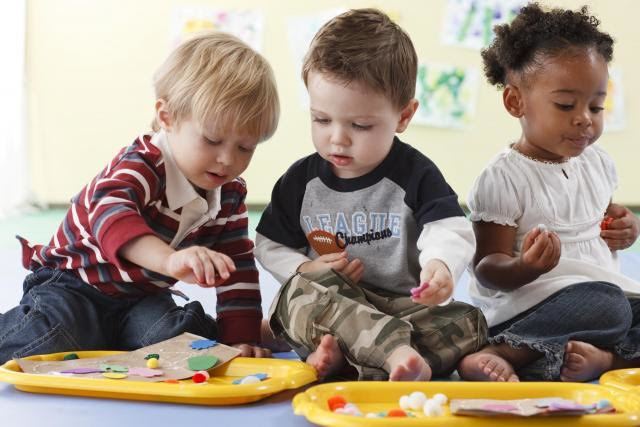Is your ten month old obsessed with nesting blocks, but doesn’t seem to want to play with the other babies in daycare or at her playgroup? Or is your preschooler all of a sudden picking up new habits, phrases, and maybe a new friend? Children go through four main stages of play, from infancy up until school age, and each stage allows your child to play at a pace appropriate for his stage of development.
Stage One
The first stage of play that infants and young toddlers are capable of is called Solitary Play. From infancy through the age of two, children are still learning about the sights, sounds, and objects that surround them. They enjoy playing on their own, or maybe with a parent or caregiver by their side for company. During this stage, children are most likely to chew on toys, bang their toys against a surface, or toss their toys, in order to learn about their properties. Eventually, they may begin to learn simple ways of playing such as rolling a ball to a parent or stacking blocks, but they won’t show an interest in actively playing with other children at this age, nor will they pay much attention to what children near them are doing.
Stage Two
When children turn two, a subtle change occurs in their play. While most children this age still prefer to play alone, they may sit next to one another, and they begin to watch what other children are doing and listen to what they’re saying. This is called Parallel Play. They won’t interact, but you might notice that your child has learned a new method of building with his blocks by watching a child at daycare. Or your little one may repeat something she heard during a playdate.
Stage 3
Associative Play begins at around the age of three. While children at this age like to play on their own, they may begin to do the same sorts of activities as the children around them. You may see your child notice another child putting sand in the back of a truck, and then she may begin to put sand in the back of her truck. Additionally, kids this age may start to have conversations while they are playing, asking to borrow toys or commenting on what another child is doing.
Stage 4
Cooperative Play marks a huge leap in a child’s ability to play and interact with other kids. When your child enters preschool, you might hear from his teacher that he has begun to share toys, play with the same toy as another child in a collaborative way, or has engaged in imaginative play with another child. Kids at this age are discovering how to communicate with each other about how they want to play, what they want to play with, and what they want to do next. These forms of communication are the building blocks of friendship, so don’t be surprised when your preschooler comes home talking about her new friend from school!
Keep in mind that every child is different. Some kids will begin noticing the games and play styles of others early, and will even communicate with other children at a younger age. And others will prefer to engage in solitary play past the age of two. And don’t fret if your child seems less social than others. Some kids are simply more independent than others, and are happy to play alone from time to time. Enjoy watching your kids engage in play, no matter what stage they’re currently in.

